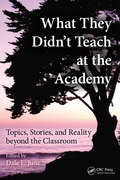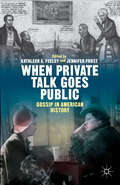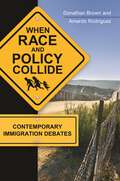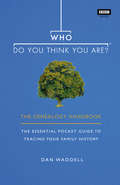- Table View
- List View
What Is Veiling? (Islamic Civilization and Muslim Networks)
by Sahar AmerRanging from simple head scarf to full-body burqa, the veil is worn by vast numbers of Muslim women around the world. What Is Veiling? explains one of the most visible, controversial, and least understood emblems of Islam. Sahar Amer's evenhanded approach is anchored in sharp cultural insight and rich historical context. Addressing the significance of veiling in the religious, cultural, political, and social lives of Muslims, past and present, she examines the complex roles the practice has played in history, religion, conservative and progressive perspectives, politics and regionalism, society and economics, feminism, fashion, and art. By highlighting the multiple meanings of veiling, the book decisively shows that the realities of the practice cannot be homogenized or oversimplified and extend well beyond the religious and political accounts that are overwhelmingly proclaimed both inside and outside Muslim-majority societies. Neither defending nor criticizing the practice, What Is Veiling? clarifies the voices of Muslim women who struggle to be heard and who, veiled or not, demand the right to live spiritual, personal, and public lives in dignity.
What Objects Mean: An Introduction to Material Culture
by Arthur Asa Berger Arthur Asa BergerArthur Asa Berger, author of an array of texts in communication, popular culture, and social theory, is back with the second edition of his popular, user-friendly guide for students who want to understand the social meanings of objects. In this broadly interdisciplinary text, Berger takes the reader through half a dozen theoretical models that are commonly used to analyze objects. He then describes and analyzes eleven objects, many of them new to this edition—including smartphones, Facebook, hair dye, and the American flag—showing how they demonstrate concepts like globalization, identity, and nationalism. The book includes a series of exercises that allow students to analyse objects in their own environment. Brief and inexpensive, this introductory guide will be used in courses ranging from anthropology to art history, pop culture to psychology.
What Objects Mean: An Introduction to Material Culture
by Arthur Asa Berger Arthur Asa BergerArthur Asa Berger, author of an array of texts in communication, popular culture, and social theory, is back with the second edition of his popular, user-friendly guide for students who want to understand the social meanings of objects. In this broadly interdisciplinary text, Berger takes the reader through half a dozen theoretical models that are commonly used to analyze objects. He then describes and analyzes eleven objects, many of them new to this edition—including smartphones, Facebook, hair dye, and the American flag—showing how they demonstrate concepts like globalization, identity, and nationalism. The book includes a series of exercises that allow students to analyse objects in their own environment. Brief and inexpensive, this introductory guide will be used in courses ranging from anthropology to art history, pop culture to psychology.
What They Didn't Teach at the Academy: Topics, Stories, and Reality beyond the Classroom
by Dale L. JuneWhile professional courses and how-to manuals can prepare us for expected events that will occur in the course of our careers, there remains an untapped reservoir of life experience that cannot be prepared for in training or study. These events and experiences give texture and meaning to our work and shape our character. Filled with stories of cour
What Works in Therapeutic Prisons: Evaluating Psychological Change in Dovegate Therapeutic Community
by J. Brown S. Miller S. Northey D. O'NeillExploring the first purpose-built prison community of its kind, the HMP Dovegate Therapeutic Community, this book provides the most comprehensive coverage of this research to date, following the progress of individual prisoners' through therapy and highlighting the key essentials for prisoners to address their motivations and criminal behaviour.
When Government Helped: Learning from the Successes and Failures of the New Deal
by Sheila D. CollinsWhen Government Helped systematically evaluates some parallels between The Great Depression and the 2007-2008 global economic meltdown, not only in terms of their economic causes and consequences, but also in terms of their political and cultural contexts and the environmental crises that afflict both periods. The positive and negative lessons for contemporary policy-making are evaluated by a multidisciplinary team of authors across a range of policy arenas. This book is a unique blend of disciplines that presents a new set of guideposts--some beneficial, some cautionary--for the future.
When Private Talk Goes Public: Gossip in American History
by Jennifer Frost Kathleen FeeleyGossip is one of the most common, and most condemned, forms of discourse in which we engage - even as it is often absorbing and socially significant, it is also widely denigrated. This volume examines fascinating moments in the history of gossip in America, from witchcraft trials to People magazine, helping us to see the subject with new eyes.
When Race and Policy Collide: Contemporary Immigration Debates
by Donathan L. Brown Amardo RodriguezExamining actual policy to identify the facts, this book exposes how racially charged political and legal debates over immigration reform in the United States continue to inform our immigration policy.Immigration reform policies continue to influence domains like housing ordinances, official language laws, mass deportation, and bilingual education, amongst many other topics. In this work, authors Donathan Brown and Amardo Rodriguez demonstrate how immigration policies belie simplistic conversations pertaining to border control. Their focus is on actual policy as opposed to mere headlines and "talking points," as it is policy and the debates that it produces that inform the headlines and subsequently incite controversy and heated arguments. Each chapter of the book addresses both policies and the fallout they produce to clearly articulate how such policies usurp fact with fiction, producing residual messages that equate "diversity" with destroying our social and political order.This accessible book provides high school, college, and graduate-level students insight into the laws and lawsuits stemming from current legislation, an understanding of the peculiar racial dimensions intertwined in these policies and debates, as well as comprehension of immigration reform against the grander backdrop of the growing Latino demographic in the United States. The authors argue that the varying degrees of immigration reform passed by state legislatures throughout the country are based on thinking that ignores the sociopolitical and cultural realities of modern-day America and continue to rely less on facts and more on fear, causing greater deep-seated paranoia, distrust, and resentment within our nation.
When Race and Policy Collide: Contemporary Immigration Debates
by Donathan L. Brown Amardo RodriguezExamining actual policy to identify the facts, this book exposes how racially charged political and legal debates over immigration reform in the United States continue to inform our immigration policy.Immigration reform policies continue to influence domains like housing ordinances, official language laws, mass deportation, and bilingual education, amongst many other topics. In this work, authors Donathan Brown and Amardo Rodriguez demonstrate how immigration policies belie simplistic conversations pertaining to border control. Their focus is on actual policy as opposed to mere headlines and "talking points," as it is policy and the debates that it produces that inform the headlines and subsequently incite controversy and heated arguments. Each chapter of the book addresses both policies and the fallout they produce to clearly articulate how such policies usurp fact with fiction, producing residual messages that equate "diversity" with destroying our social and political order.This accessible book provides high school, college, and graduate-level students insight into the laws and lawsuits stemming from current legislation, an understanding of the peculiar racial dimensions intertwined in these policies and debates, as well as comprehension of immigration reform against the grander backdrop of the growing Latino demographic in the United States. The authors argue that the varying degrees of immigration reform passed by state legislatures throughout the country are based on thinking that ignores the sociopolitical and cultural realities of modern-day America and continue to rely less on facts and more on fear, causing greater deep-seated paranoia, distrust, and resentment within our nation.
When the Innocent are Punished: The Children of Imprisoned Parents (Palgrave Studies in Prisons and Penology)
by Peter Scharff SmithThere are millions of children experiencing parental imprisonment all over the world. This book is about their problems, human rights and how they are treated throughout the justice process from the arrest of a parent to imprisonment and release.
When the Lamps Went Out: Reporting the Great War 1914–1918
by Nigel Fountain'The lamps are going out all over Europe; we shall not see them lit again in our life-time.' Sir Edward Grey, British foreign secretary, 3 August 1914. Drawing on a wealth of material from the Guardian archives When the Lamps Went Out presents a surprising, immediate, sometimes bleakly humorous, sometimes horrifying insight into life during the Great War. We see Boy Scouts patrolling the British coasts, David Lloyd George addressing women war workers, Charlie Chaplin impersonators on the Euston Road and Vesta Tilley at the Ardwick Empire. We see suffragist nurses on the Western Front and Bolsheviks in Glasgow, Pathan soldiers in Flanders and Anglo-Japanese armies in China. Small countries are saved - and aliens persecuted.New technologies - from picture houses to the first reports of gas weapons - are reported upon, as well as movie stars and John Buchan's bestsellers. The bloody battles, defeats, and victories are all here but When the Lamps Went Out focuses on the women, men and children who lived, loved, defied, perished, and survived in the war to end all wars.
When the Machine Made Art: The Troubled History of Computer Art (International Texts in Critical Media Aesthetics)
by Grant D. TaylorConsidering how culturally indispensable digital technology is today, it is ironic that computer-generated art was attacked when it burst onto the scene in the early 1960s. In fact, no other twentieth-century art form has elicited such a negative and hostile response. When the Machine Made Art examines the cultural and critical response to computer art, or what we refer to today as digital art. Tracing the heated debates between art and science, the societal anxiety over nascent computer technology, and the myths and philosophies surrounding digital computation, Taylor is able to identify the destabilizing forces that shape and eventually fragment the computer art movement.
When the Machine Made Art: The Troubled History of Computer Art (International Texts in Critical Media Aesthetics)
by Grant D. TaylorConsidering how culturally indispensable digital technology is today, it is ironic that computer-generated art was attacked when it burst onto the scene in the early 1960s. In fact, no other twentieth-century art form has elicited such a negative and hostile response. When the Machine Made Art examines the cultural and critical response to computer art, or what we refer to today as digital art. Tracing the heated debates between art and science, the societal anxiety over nascent computer technology, and the myths and philosophies surrounding digital computation, Taylor is able to identify the destabilizing forces that shape and eventually fragment the computer art movement.
Where the Negroes Are Masters: An African Port In The Era Of The Slave Trade
by Randy J. SparksAnnamaboe--largest slave trading port on the Gold Coast--was home to wily African merchants whose partnerships with Europeans made the town an integral part of Atlantic webs of exchange. Randy Sparks recreates the outpost's feverish bustle and brutality, tracing the entrepreneurs, black and white, who thrived on a lucrative traffic in human beings.
Where the Negroes Are Masters: An African Port In The Era Of The Slave Trade
by Randy J. SparksAnnamaboe--largest slave trading port on the Gold Coast--was home to wily African merchants whose partnerships with Europeans made the town an integral part of Atlantic webs of exchange. Randy Sparks recreates the outpost's feverish bustle and brutality, tracing the entrepreneurs, black and white, who thrived on a lucrative traffic in human beings.
White Magic: The Age of Paper
by Lothar MüllerPaper is older than the printing press, and even in its unprinted state it was the great network medium behind the emergence of modern civilization. In the shape of bills, banknotes and accounting books it was indispensible to the economy. As forms and files it was essential to bureaucracy. As letters it became the setting for the invention of the modern soul, and as newsprint it became a stage for politics. In this brilliant new book Lothar Müller describes how paper made its way from China through the Arab world to Europe, where it permeated everyday life in a variety of formats from the thirteenth century onwards, and how the paper technology revolution of the nineteenth century paved the way for the creation of the modern daily press. His key witnesses are the works of Rabelais and Grimmelshausen, Balzac and Herman Melville, James Joyce and Paul Valéry. Müller writes not only about books, however: he also writes about pamphlets, playing cards, papercutting and legal pads. We think we understand the ?Gutenberg era?, but we can understand it better when we explore the world that underpinned it: the paper age. Today, with the proliferation of digital devices, paper may seem to be a residue of the past, but Müller shows that the humble technology of paper is in many ways the most fundamental medium of the modern world.
White Magic: The Age of Paper
by Lothar MüllerPaper is older than the printing press, and even in its unprinted state it was the great network medium behind the emergence of modern civilization. In the shape of bills, banknotes and accounting books it was indispensible to the economy. As forms and files it was essential to bureaucracy. As letters it became the setting for the invention of the modern soul, and as newsprint it became a stage for politics. In this brilliant new book Lothar Müller describes how paper made its way from China through the Arab world to Europe, where it permeated everyday life in a variety of formats from the thirteenth century onwards, and how the paper technology revolution of the nineteenth century paved the way for the creation of the modern daily press. His key witnesses are the works of Rabelais and Grimmelshausen, Balzac and Herman Melville, James Joyce and Paul Valéry. Müller writes not only about books, however: he also writes about pamphlets, playing cards, papercutting and legal pads. We think we understand the ?Gutenberg era?, but we can understand it better when we explore the world that underpinned it: the paper age. Today, with the proliferation of digital devices, paper may seem to be a residue of the past, but Müller shows that the humble technology of paper is in many ways the most fundamental medium of the modern world.
White Migrations: Gender, Whiteness and Privilege in Transnational Migration (Migration, Diasporas and Citizenship)
by C. LundströmFrom a multi-sited ethnography with Swedish migrant women in the United States, Singapore and Spain, the book explores gender vulnerabilities and racial and class privilege in contemporary feminized migration, filling a gap in literature on race and migration.
White Voters in 21st Century America (Routledge Research in American Politics and Governance)
by George HawleyThe United States is experiencing remarkable demographic changes that are having an important impact on the American electorate. As the minority share of the voting-eligible population continues to grow, the political clout of non-Hispanic whites will further decline. The 2012 election demonstrated that the Democratic Party can secure an Electoral College victory even when it loses badly, in the aggregate, among non-Hispanic whites. This does not mean that white voters are unimportant, however. The political behavior of whites in the decades ahead will largely determine the direction of American politics. This book examines the political behavior of non-Hispanic whites. It considers the trends within the white vote, how white voters differ geographically, and the primary fault lines among white voters. It also examines how white political behavior changes in response to diversity. It considers whether or not the day is approaching when whites consolidate into a largely homogenous voting bloc, or whether whites will remain politically heterogeneous in the decades ahead Whereas other books have examined the political behavior of specific social classes within the non-Hispanic white community (working class whites, for example), this is the first book to examine whites as a whole, and provide a useful summary of recent trends within this group and thoughtful speculation about its future.
White Voters in 21st Century America (Routledge Research in American Politics and Governance)
by George HawleyThe United States is experiencing remarkable demographic changes that are having an important impact on the American electorate. As the minority share of the voting-eligible population continues to grow, the political clout of non-Hispanic whites will further decline. The 2012 election demonstrated that the Democratic Party can secure an Electoral College victory even when it loses badly, in the aggregate, among non-Hispanic whites. This does not mean that white voters are unimportant, however. The political behavior of whites in the decades ahead will largely determine the direction of American politics. This book examines the political behavior of non-Hispanic whites. It considers the trends within the white vote, how white voters differ geographically, and the primary fault lines among white voters. It also examines how white political behavior changes in response to diversity. It considers whether or not the day is approaching when whites consolidate into a largely homogenous voting bloc, or whether whites will remain politically heterogeneous in the decades ahead Whereas other books have examined the political behavior of specific social classes within the non-Hispanic white community (working class whites, for example), this is the first book to examine whites as a whole, and provide a useful summary of recent trends within this group and thoughtful speculation about its future.
Who Do You Think You Are?: The Genealogy Handbook
by Dan WaddellDo you know where you came from? Who Do You Think You Are? has been a BBC hit since its first series in 2004, which ignited an extraordinary boom in researching family history in the UK. Since then, the world of genealogy has transformed and while our sources of information remain the same, our ways of accessing them have multiplied and changed beyond recognition. In this practical, easy-to-use handbook, the WDYTYA? team share their experience and expertise, essential for anyone who would like to discover their family’s history.Drawing on celebrity stories to illustrate and inspire, and providing hints, tips and practical step-by-steps this pocket handbook will bring family history to life for fans of the show, and for any amateur sleuths starting out on their own journey of discovery.
Who Killed the Berkeley School? Struggles Over Radical Criminology: Struggles Over Radical Criminology (Thought Crimes Ser.)
by Herman Schwendinger Julia SchwendingerThe Berkeley School of Criminology stands, to this day, as one of the most significant developments in criminological thought and action. Its diverse participants, students and faculty, were true innovators, producing radical social analyses (getting to the roots causes) of institutions of criminal justice as part of broader relations of inequality, injustice, exploitation, patriarchy, and white supremacy within capitalist societies. Even more they situated criminology as an active part of opposition to these social institutions and the relations of harm they uphold. Their criminology was directly engaged in, and connected with, the struggles of resistance that emerged in the late 1960s and early 1970s. Not surprisingly perhaps, they became a target of regressive and reactionary forces that sought to quiet those struggles. Notably the Berkeley School of Criminology was targeted by key players in the US military-industrial complex such as Ronald Reagan himself, then Governor of California and Regent of UC-Berkeley. Who Killed the Berkeley School? by Julia and Herman Schwendinger, key players in the Berkeley School, is the first full-length, in-depth analysis, of the Berkeley School of Criminology, its participants, and the attack against it. It tells the story of an important infrastructure of resistance, a resource of struggle, and how it was dismantled. It lays bare the role not only of conservatives but of liberal academics and false critical theorists, who failed to stand up in defense of the School and its work when called upon. This is a story with profound lessons in the current period of corporatization of campuses, neoliberal education, and market-driven curricula. It will be of interest to anyone concerned with developing resistance to the corporate campus and seeking critical alternatives. It also stands as a challenge to social science disciplines, including criminology, to develop a practice that identifies the roots of social injustice and organizes to confront it.
Who Knows Tomorrow: A Memoir of Finding Family among the Lost Children of Africa
by Lisa Lovatt-SmithBorn in Spain and raised by a struggling single mother, Lisa Lovatt-Smith became an editor at British Vogue at nineteen, the youngest in Condé Nast history. She helped launch Spanish Vogue and partied across Europe with celebrities, fashion designers, photographers, and supermodels.By her thirties, Lisa has her dream career and a glamorous life in Paris, but when her adopted daughter Sabrina is expelled from school, Lisa takes her to volunteer in a Ghanaian orphanage in the hopes of getting her back on track. What she discovers there changes both their lives for good.Appalled by the deplorable conditions she finds, Lisa moves to Ghana permanently and founds OAfrica, dedicating her personal resources to reuniting hundreds of Ghanaian children with their families and spearheading a drive to shut down corrupt orphanages. On this unforgettable journey, Lisa confronts death threats, malaria, arson, and heartbreaking poverty; she also discovers truly inspiring children trapped in limbo by a moneymaking scheme bigger than she ever imagined.Who Knows Tomorrow is the engaging, frank, and often surprisingly funny story of one amazing woman who has traveled the globe in search of meaningful connection. Although to Lisa her story will always be about the children, it's also a touching celebration of a woman who is talented, generous, and unfailingly courageous.
Who Needs Experts?: Counter-mapping Cultural Heritage (Heritage, Culture and Identity)
by John SchofieldTaking the significant Faro Convention on the Value of Cultural Heritage for Society (Council of Europe 2005) as its starting point, this book presents pragmatic views on the rise of the local and the everyday within cultural heritage discourse. Bringing together a range of case studies within a broad geographic context, it examines ways in which authorised or 'expert' views of heritage can be challenged, and recognises how everyone has expertise in familiarity with their local environment. The book concludes that local agenda and everyday places matter, and examines how a realignment of heritage practice to accommodate such things could usefully contribute to more inclusive and socially relevant cultural agenda.
Who Needs Experts?: Counter-mapping Cultural Heritage (Heritage, Culture and Identity)
by John SchofieldTaking the significant Faro Convention on the Value of Cultural Heritage for Society (Council of Europe 2005) as its starting point, this book presents pragmatic views on the rise of the local and the everyday within cultural heritage discourse. Bringing together a range of case studies within a broad geographic context, it examines ways in which authorised or 'expert' views of heritage can be challenged, and recognises how everyone has expertise in familiarity with their local environment. The book concludes that local agenda and everyday places matter, and examines how a realignment of heritage practice to accommodate such things could usefully contribute to more inclusive and socially relevant cultural agenda.



















